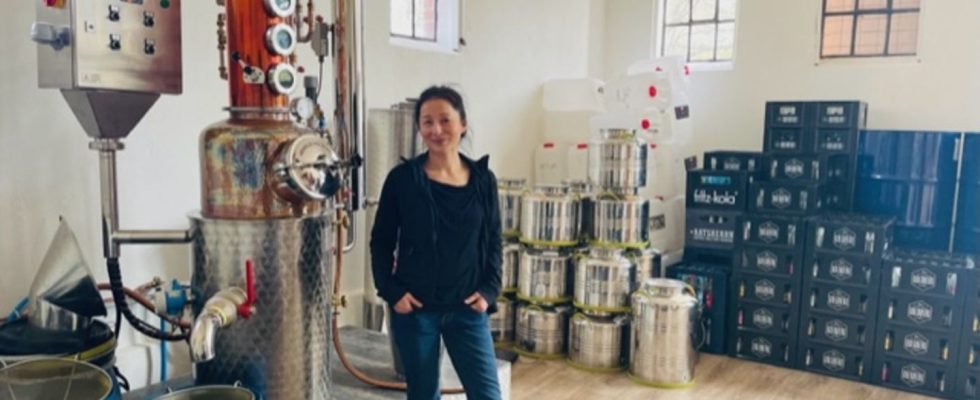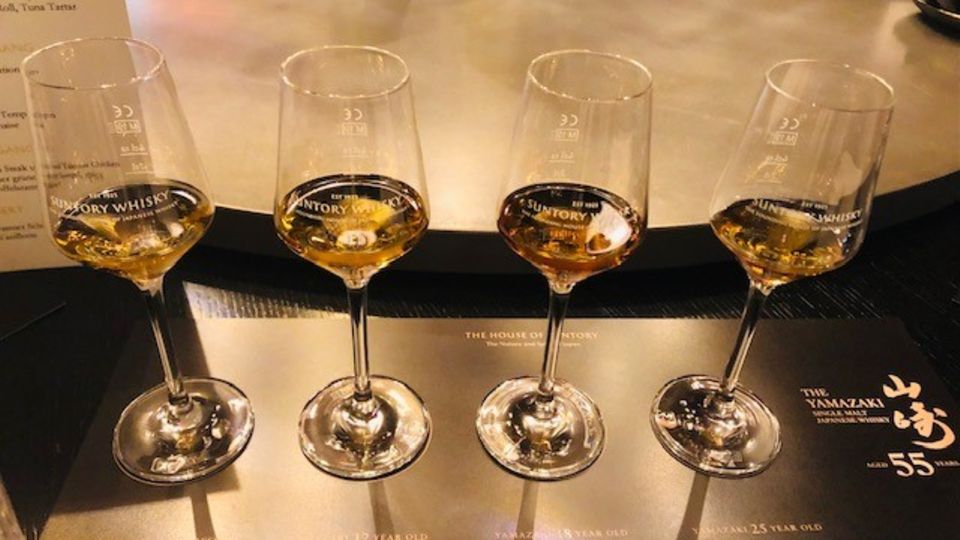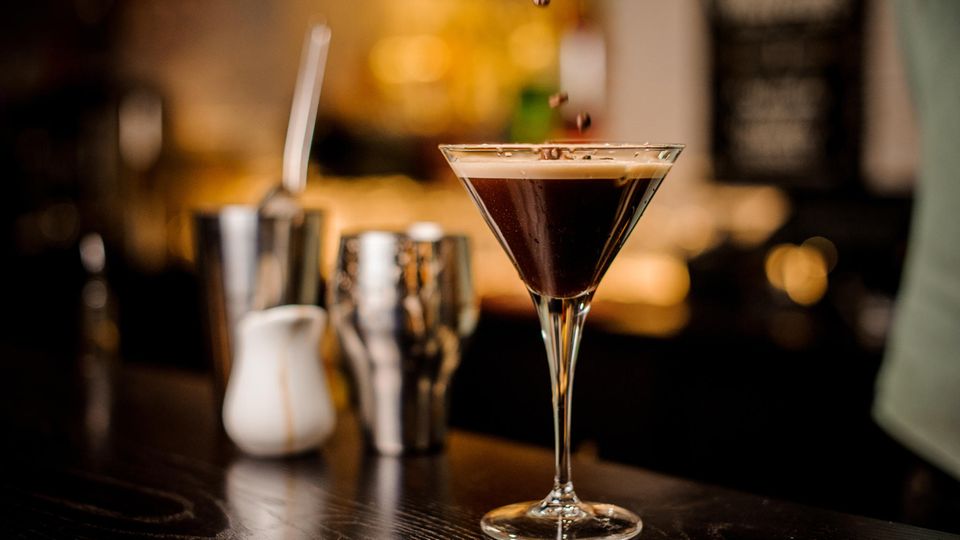Two hamburgers show the world how modern gin should taste. They scoop up one award after the next. How do they do it? All coincidence, they say. The story of absolute career changers who still know how to dream.
It is small, this copper distillery, with a diameter of little more than the size of the palm of your hand, its distillate just fills a shot glass. The burning, you could call it a gimmick. And actually it was exactly what Hauke Günther had in mind in 2017, in the evenings of parental leave, when the children were in bed – distraction. Gin, that couldn’t be that difficult: juniper berries, you could get them at hardware stores, and vodka. That a few years later the best gin in the world would come from this miniature distillery was actually a nonsense. Or coincidence, as Hauke calls it. Because if he was just a little bit more knowledgeable about spices, the Tumeric No.1 would never have made it into the bottles.
If you follow the online infographic World Gin Map, there are around 5,500 different types of gin worldwide, around 700 come from Germany alone. That’s third place after the UK and the US. And the market keeps growing. A development that was not foreseeable. Because up until a few years ago, juniper schnapps was not only out of fashion, it was dismissed as cheap booze. In the meantime, however, the gin has become so popular that it is no longer trendy, it has arrived in mainstream taste.
The gin business is booming and Hauke and his wife Yuka Suzuki are among the pacesetters. He, who is actually a biologist, and she, who recently taught yoga, burn gin that regularly puts hearts in the eyes of experts. They collect award after award. They never wanted to turn the gin into a business, as they say. Especially not back then, when they still had to work with the mini still for three weekends to fill the mini bottles jar by jar. Those were party favors, nothing more. The business just kind of happened anyway. coincidence.
Kitchen experiments with turmeric
The story of Zanzibar gin begins on an island off the coast of East Africa, Zanzibar. From there, Hauke brings a powder that he takes to be ground tamarind. Tumeric, tamarind – well. You could make lemonade with it, that’s the idea. After the trip, the sachet disappears into the spice rack above the sink, moves from the first row to the second, to the third and eventually out of your mind. Until he gets his hands on it again during his burning experiments.
The spice gives the Heim-Gin a twist that is so different that even Yuka (“I actually prefer drinking rum”) succumbs to the spicy earthiness and the wood nuances. When red pepper is added to the turmeric later, the gin is round. However, they did not think that one could earn money with him. Distilling remained a hobby.
It wasn’t until they ventured out of the kitchen with their gin. To do this, they canceled their vacation and instead had a first batch burned at a small distillery. 350 bottles. They built a Jimdo website, set up an Instagram page and drove from store to store in their car: acquisition. It was slow.
The two were convinced of their gin. It’s a bit like having your own children, says Yuka. They are always the greatest and the best. However, many others would not have understood the gin. “He’s weird too,” she smiles. The Hamburg-Zanzibar Gin is not for the mainstream palate, more like the orchid in the flower bed, the two quickly noticed. But what would a dream be without a little madness?

The Zanzibar distillery is still the smallest gin distillery in the city.
© Tina Pokern
World’s best gin from the smallest distillery
It’s hard to explain why the Hamburg-Zanzibar distillery is where it is today, in this old barn from the 17th century on the outskirts of Hamburg. Because the decision that the couple made at the end of parental leave, which was in 2019, was more than just daring. “It was a completely stupid idea that really shouldn’t have worked,” says Hauke in retrospect.
But he had dreamed of setting up a still there long before the rooms became vacant. When the chance presented itself, it was clear that this is one that only falls at your feet once in a lifetime. So they squeezed out of the bank what could still be squeezed out and, as Hauke puts it, threw in their towel. They had no plan as to what exactly was to be created there. The booth was initially empty.
“We made so many mistakes – entrepreneurially,” he says. “We are super unprofessional and do everything wrong at first.” After not only the warm rain of money had failed, but also the corona pandemic intervened, Hauke was frustrated enough at some point to let the juniper berries be juniper berries. Remembering that time, he looks a few years older, downright exhausted. There was that moment when quitting was an option. Instead, they played bells and whistles to participate in the World Gin Awards 2021, submitted their Tumeric No.1 and became world famous overnight.
“It was clear, this is life changing”
On the February evening of the ceremony, they were making sandwiches, the stream was running in the background, when their name was mentioned. Their outsider, the Tumeric No.1, was voted the country’s best flavored gin, and shortly afterwards the best in the world. “We jumped through the kitchen like crazy. The kids didn’t know what was going on,” Yuka remembers that moment.
“It quickly became clear that this was life-changing,” adds Hauke. The two didn’t have time to celebrate. Suddenly, one order after the next tumbled into the mailbox. At that time they produced, now with a 40 liter still, just 30 bottles a month. Far too little to even come close to covering the torrential demand. “So there you have this gin, you think that’s the holy grail and you can’t do anything with it,” he says.
Yuka started his own business right after parental leave, and in 2021 Hauke also quit his job to only work on the gin. 100 hours a week, from morning to night. Three or four hours of sleep, that’s all we had. “Everyone wanted gin, but we didn’t have anything,” he says. At some point people would even have stood in bunches in front of the distillery, but there was nothing that could have been sold. “Everything we bottled has already been sold ten times and people still had to wait twelve weeks for their order.”
Hamburg-Zanzibar-Gin wins award after award
The Tumeric No.1 was just the beginning. The following year, the Tumeric Raw Gin won the title of the best flavored gin in Germany – and then there is the story of the Suburban, the distillery’s first classic gin. Originally little more than a trial balloon. The batch was enough for 15 bottles, three they sent to London. It was unimaginable for both of them that the gin – “we put it together like this” – could break anything at the World Gin Awards. They didn’t even make it to the ceremony. But again the Hamburgers conceded. The third gin in the range was also voted the best in the world in its category.
Yuka and Hauke are career changers, as they are in the book. They started from scratch, without the right equipment, without real know-how. Even today it seems as if they are surprised at their success. “He comes home every day and says that now he knows how to do it, now he has it,” she laughs. He grins and says that he learns something new every day, something he hadn’t had for a long time. Then he shakes his head almost in disbelief, “I always thought I was the sort of biologist who could enjoy a blade of grass for the rest of his life.”
Better under the radar
Instead, he keeps tinkering with new products in his distillery, the Droppies for example. They are the distillery’s answer to the trend towards so-called non-alcoholic spirits. For this, the gin was broken down into its individual parts and the alcohol removed. If you add some of the highly concentrated essence to the tonic with the pipette, the gin aroma unfolds. “Simple actually,” he says. He always wondered why the other distillers make it so difficult. The Droppies are the only product of the distillery so far that does not bear the title of world’s best.
To this day, the Hamburg-Zanzibar Gin comes from the smallest distillery in Hamburg. In the meantime, the old barn is not only used for distilling, but also for the distillery shop, where tastings also take place. However, the production is still very limited and should stay that way. The couple is flirting with a larger distillery, instead of 40 liters 80 or even 100, then up to 5000 bottles a month could be produced, but that’s about it. They want to stay small and preserve the uniqueness of their gin. “We prefer to stay a little under the radar, an insider tip,” she says. He adds: “It is clear to us that we will always produce ourselves.”




